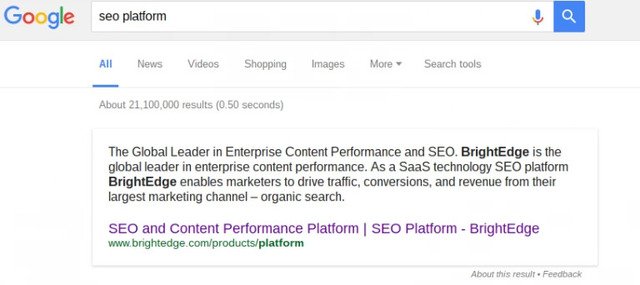SEO 2016 has been eventful thus far for marketing professionals. SEOs need to keep up not only with the changing expectations of the users, but they also need to adapt to the algorithm and SERP adjustments made by the search engines themselves.
Brands need to pay attention to these changes. An estimated 93 percent of online experiences begin with a search engine, so understanding how to maximize the visibility of your site on the SERPs can result in a tremendous boost in traffic, engagement, and conversions.
At the beginning of the year, I explored some growing trends that we anticipated for SEO 2016. Now that we are half way through the year, I thought it would be a great opportunity to see how these predictions have been panning out.
1) The growth of schema in SEO 2016
Schema has long been a recommended optimization strategy for website owners. The markups make it easier for the major search engines Google, Yahoo, Bing, and Yandex to interpret the different elements of your site so that your material can be appropriately displayed in the SERPs.
Developing changes, however, have made these markups even more significant. We noted in our predictions at the beginning of the year that schema would become more significant as artificial intelligence grows in importance, and in light of the ongoing major knowledge graph and SERP changes the value of the markup has remained consistent with our expectations. Google schema provides structured data analysis for web sites.
2) Quick Answers in SEO 2016
The Google Quick Answer-- a snippet answer that is offered at the top of the SERP in response to certain queries-- has been increasing in usage. According to studies conducted by Stone Temple Consulting, their usage grew from 22.6 percent of queries in December 2014 to over 40 percent by the beginning of 2016. For SEO 2016, brands should be optimizing their content to gain the attention needed for a Quick Answer box. Gaining this recognition can provide your site with a boost in click-throughs and qualified organic traffic.

Using schema is an important step in optimizing for the Google Quick Answer since it helps the search engine quickly scan your content and find the snippets that you are qualified to provide. Download our expert's guide How to Get into Quick Answers.
3) RankBrain in SEO 2016
We started talking about RankBrain at the end of 2015 when Google announced that they were including this as a new factor in their algorithm. RankBrain was designed to use machine learning so that the algorithm would better understand what people wanted to see when they entered unique queries.
Schema is also a valuable part of optimizing for this artificial intelligence. Since RankBrain relies on machine learning, these types of markups make it easier for the algorithm to interpret and understand what is on the page. This helps it better match the material with users and provide a superior experience for the person searching.

4) The Introduction of Rich Cards in SEO 2016
In the summer of 2015, Google introduced a new carousel display for certain queries on mobile. For example, if you were looking for decorating ideas for your living room, you could now scroll through a series of pictures along the top of your screen.
In May 2016 Google took this even further and began using rich cards for certain queries within these carousels. Currently, these rich cards apply to recipes and movies, but there is a possibility of the change applying to other types of queries in the future. These rich cards help to make your site look more appealing while also supplying users with helpful information right on the SERP.
For your site to appear in an applicable rich card format, however, the page must be marked up. Using schema can help ensure that the algorithm properly interprets your site and that you are able to take advantage of any rich display options that become available.
5) The Importance of Speed in SEO 2016
Most site owners already know that speed is an important part of creating a successful site. Site visitors quickly click off of pages that take too long to load-- just a 3 second delay will cause 40 percent to click off and a 1 second delay can cause a 7 percent drop in conversions. In SEO 2016, however, we have seen the importance of speed expand even further.
In late 2015, Google introduced the concept of AMP pages-- pages that are designed to load particularly fast on mobile devices, improving the user experience and boosting the brand's reputation. This format strips sites of nearly everything extra, creating a page that contains only the bare necessities and can load between 15 and 85 percent faster than it did before the optimization process.

While the AMP system was originally largely used by news sites, it has recently begun to expand beyond these initial parameters. Ebay officially announced that it had optimized as many as 8 million pages for AMP in an effort to provide people with a better buying experience.
Brands that do not center around news articles or e commerce, however, should still be paying attention to the growing need for speed. As AMP continues to spread and its impact on consumers is measured, it is very likely that this new system will be employed by an increasing number of brands.
Even outside of AMP, these changes will be impacting the expectations of consumers. People will now have less tolerance for slow-loading sites as a growing number of brands cater to their expressed desire for speed. For brands to remain competitive with SEO 2016, they cannot overlook the importance of a fast load time.
These quick ideas will help improve your loading speed:
- Do not use any unnecessary cookies
- Simplify images as much as possible and do not use oversized shots-- scale the images before you upload them
- Enable browser caching so that your site can store some data on your visitor’s computer, which then helps your site load faster the next time someone visits
- Consider compressing your website
At the beginning of the year, we touched upon the growing importance of micro-moments and how brands can remain relevant to these customers. AMP, and maintaining quick loading speeds, will be an important part of serving these desires of on-the-go consumers.
Specifically, currently those with the I-want-to-know moments can load news sites faster and those in the I-want-to-buy moments will experience benefits from the optimization of pages for e commerce. As AMP spreads and brands begin to pay attention to the importance of speed, sites will be able to better meet the needs of their visitors and take advantage of the micro-moment, bringing more customers into their funnels.
6) SERP Layout Changes in SEO 2016
So far for SEO 2016 we have also seen several changes in the layouts of the SERPs that impact how site owners can optimize their domain to maximize their appearance on the results page.
In February we saw a change in how Google displayed ads. Specifically, they eliminated the ads that once populated the space along the side of the results and increased the number of ad results along the top of the page. Some queries can see as many as four ad results before the organic results begin. This reduces the available real estate for organic results above the fold.

We have also seen Google experiment with increasing the space available for titles and meta descriptions. Although the increases have not been universal, many sites see more characters available in these spaces now, providing them with the opportunity to offer more detail about the value they have for visitors.

What these SEO 2016 layout changes mean for brands
Given that there are fewer spaces available above the fold for organic search results, brands must place an even stronger emphasis on earning the top organic spots offered. This means paying attention to optimization details such as:
- Writing content that is centered around a topic that matters to the target audience
- Creating material that offers obvious value for users
- Including your keywords in the title, a heading, and naturally in the body of the text
- Using images to make your content look appealing
- Creating a strong distribution system to attract attention to your content
Brands should also open themselves up to experimenting more with their titles and meta descriptions. Since these changes have not been universal and we have no way of knowing if they are permanent, you do not want to write your sections with the assumption that the extra space will always be there. Instead, you should use your target keyword in the beginning of your title and description and use the additional characters to elaborate on the value you offer the audience.
As any site owner knows, optimization best practices change at lightning speed as the search engines continue to adjust their algorithms to better account for user expectations and the pace of technology. SEO 2016 has proven to be no different as the first half of the year has already seen tremendous changes that impact how you should develop your site. Keep these changes in mind as you move forward and we will work to ensure that you have the latest information as the Google algorithm and customers evolve.
